Witch-hazel
Witch-hazels or witch hazels (Hamamelis) are a genus of flowering plants in the family Hamamelidaceae, with three species in North America (H. ovalis,[1] H. virginiana, and H. vernalis), and one each in Japan (H. japonica) and China (H. mollis). The North American species are occasionally called winterbloom.[2][3]
| Witch-hazel | |
|---|---|
 | |
| Hamamelis virginiana | |
| Scientific classification | |
| Kingdom: | Plantae |
| Clade: | Tracheophytes |
| Clade: | Angiosperms |
| Clade: | Eudicots |
| Order: | Saxifragales |
| Family: | Hamamelidaceae |
| Subfamily: | Hamamelidoideae |
| Tribe: | Hamamelideae |
| Genus: | Hamamelis Gronov. ex L. |
| Type species | |
| Hamamelis virginiana L. | |
Growth
The witch-hazels are deciduous shrubs or (rarely) small trees growing to 10–25 feet (3.0–7.6 m) tall, rarely to 40 ft (12 m) tall. The leaves are alternately arranged, oval, 2–6 in (5.1–15.2 cm) long and 1–4 in (2.5–10.2 cm) broad, with a smooth or wavy margin. The genus name, Hamamelis, means "together with fruit", referring to the simultaneous occurrence of flowers with the maturing fruit from the previous year.[4] H. virginiana blooms in September–November while the other species bloom from January–March. Each flower has four slender strap-shaped petals 3⁄8–3⁄4 inch (0.95–1.91 cm) long, pale to dark yellow, orange, or red. The fruit is a two-part capsule 3⁄8 inch (0.95 cm) long, containing a single 1⁄4 inch (0.64 cm) glossy black seed in each of the two parts; the capsule splits explosively at maturity in the autumn about 8 months after flowering, ejecting the seeds with sufficient force to fly for distances of up to 30 ft (9.1 m), thus another alternative name "Snapping Hazel".
Etymology
The name witch in witch-hazel has its origins in Middle English wiche, from the Old English wice, meaning "pliant" or "bendable", and is not related to the word witch meaning a practitioner of magic.[5] Jacob George Strutt's 1822 book, Sylva Britannica attests that "Wych Hazel" was used in England as a synonym for wych elm, Ulmus glabra;[6] The use of the twigs as divining rods, just as hazel twigs were used in England, may also have, by folk etymology, influenced the "witch" part of the name.[3]
Species
Five species are recognized:[7]
- Hamamelis japonica Siebold & Zucc.
- Hamamelis mollis Oliv.
- Hamamelis ovalis S.W.Leonard
- Hamamelis vernalis Sarg.
- Hamamelis virginiana L.
Hamamelis mexicana is sometimes considered a species,[8] though as of 2020 Kew's Plants of the World Online considers it a variety of H. virginiana.[7]
The Persian ironwood, a closely related tree formerly treated as Hamamelis persica, is now given a genus of its own, as Parrotia persica, as it differs in the flowers not having petals. Other closely allied genera are Parrotiopsis, Fothergilla, and Sycopsis (see under Hamamelidaceae). Witch-hazels are not closely related to the true Corylus hazels, though they have a few superficially similar characteristics which may cause one to believe that they are.
Cultivation
They are popular ornamental plants, grown for their clusters of rich yellow to orange-red flowers which begin to expand in the autumn as or slightly before the leaves fall, and continue throughout the winter.
Garden shrubs
Hamamelis virginiana was introduced into English gardens by Peter Collinson, who maintained correspondence with plant hunters in the American colonies. Nowadays, it is rarely seen in the nursery trade except for woodland/wildlife restoration projects and native plant enthusiasts. Much more common is H. mollis, which has bright yellow flowers that bloom in late winter instead of the yellow blossoms of H. virginiana which tend to be lost among the plant's fall foliage. The plant-hunter Charles Maries collected for Veitch Nurseries in the Chinese district of Jiujiang in 1879. It languished in nursery rows for years until it was noticed, propagated and put on the market in 1902.[9]
Numerous cultivars have been selected for use as garden shrubs, many of them derived from the hybrid H. × intermedia Rehder (H. japonica × H. mollis). Jelena and Robert de Belder of Arboretum Kalmthout, selecting for red cultivars, found three: the first, with bronze flowers, was named 'Jelena'; the next, with red flowers, was named 'Diane' (the name of their daughter); the last, with deep red flowers, was called 'Livia' (the name of their granddaughter).
Phytochemicals and hamamelis water
The main phytochemicals in witch-hazel leaves are polyphenols, including 3–10% tannins, flavonoids, and up to 0.5% essential oil, while the bark has a higher tannin content.[10][11] Hamamelis water, also called white hazel or witch hazel water prepared from a steam-distillation process using leaves, bark or twigs, is a clear, colorless liquid containing 13–15% ethanol having the odor of the essential oil, but with no tannins present.[10][11] Essential oil components, such as carvacrol and eugenol, may be present.[12]
As an ingredient and topical agent, witch-hazel water is regulated in the United States as an over-the-counter drug for external use only to soothe minor skin irritations.[13] Hamamelis (witch-hazel) water is diluted using water in a 1:3 preparation, and is not intended for oral use which may cause nausea, vomiting, or constipation.[11]
Topical ointment
Witch-hazel may be sold as a semisolid ointment, cream, gel, or salve for topical use.[11][14] The ointment may ease discomfort from post-partum vaginal soreness and hemorrhoids.[11][15] It is commonly used to treat diaper rash in infants, and may reduce symptoms of inflammation from minor skin injuries.[11] A 2012 review (updated in October 2020) found little evidence of effectiveness from local cooling treatments (including witch-hazel pads) applied to the perineum following childbirth to relieve pain.[16]
Folk medicine
The leaves and bark of the North American witch-hazel, Hamamelis virginiana, were used in folk medicine, herbalism, and skincare decoctions by Native Americans, and is commonly used for folk remedies in the European Union.[10][11][3] Extracts of witch-hazel may be used as a remedy for psoriasis and eczema, in aftershave and ingrown nail applications, to prevent dehydration of skin, and for insect bites and poison ivy.[17] There is no clinical evidence to support witch-hazel as an effective treatment for any of these conditions.[11] Prepared by distillation, the essential oil of witch-hazel has such a small proportion of tannins or other polyphenols that it is unlikely to have any therapeutic effect, and may cause contact dermatitis when used topically.[10][11]
In 2017, one manufacturer of skincare products containing witch-hazel was warned by the Food and Drug Administration for making unsubstantiated health claims and for not providing evidence the products are safe.[18]
History
Early Puritan settlers in New England adopted witch-hazel as a supposed remedy from the natives, and its use became widely established in the United States during the 19th century.[17] A missionary, Dr. Charles Hawes, adopted the process of steam distillation of witch-hazel twigs,[17] creating a "Hawes Extract" product sold in Essex, Connecticut in 1846, by druggist and chemist, Alvan Whittemore.[19] Hawes' process was further refined by Thomas Newton Dickinson, Sr., who is credited with starting the commercial production of witch-hazel extract, also in Essex, Connecticut, in 1866, and eventually establishing nine production sites in eastern Connecticut during the 20th century.[17][20] Following his death, his two sons, Thomas N. Dickinson, Jr., of Mystic, Connecticut, and Everett E. Dickinson of Essex, each inherited parts of the family business and continued the manufacture of witch-hazel extract, operating competing "Dickinson's" businesses that were continued by their descendants until 1997 when the businesses closed.[17]
Gallery
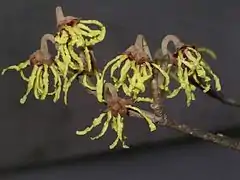 Hamamelis sp. flowers, Menai Bridge, Wales
Hamamelis sp. flowers, Menai Bridge, Wales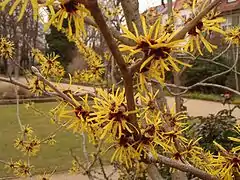 Hamamelis in Fürth City Park (Germany), 2004-02-08
Hamamelis in Fürth City Park (Germany), 2004-02-08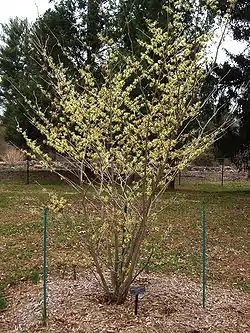 Hamamelis in the Colonial Park Arboretum and Gardens
Hamamelis in the Colonial Park Arboretum and Gardens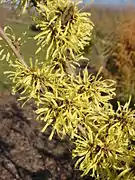 Hamamelis ×intermedia (H. japonica × H. mollis)
Hamamelis ×intermedia (H. japonica × H. mollis)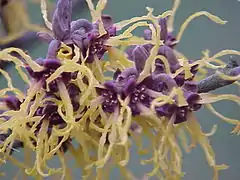 Hamamelis japonica
Hamamelis japonica
close-up flowers Hamamelis ×intermedia 'Jelena'
Hamamelis ×intermedia 'Jelena' Hamamelis ×intermedia 'Diane'
Hamamelis ×intermedia 'Diane'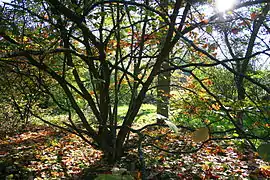 Hamamelis mollis tree in autumn
Hamamelis mollis tree in autumn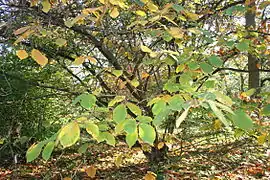 Hamamelis mollis in autumn
Hamamelis mollis in autumn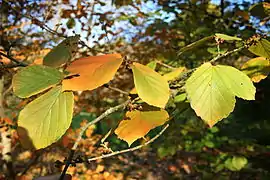 Hamamelis mollis leaves in autumn
Hamamelis mollis leaves in autumn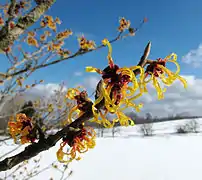 Winter-flowering in the Vogelsberg Mountains
Winter-flowering in the Vogelsberg Mountains Flourishing Witch-hazel shrub in winter
Flourishing Witch-hazel shrub in winter
References
- Hamamelis ovalis S. W. Leonard (2006), GRIN Taxonomy for Plants
- Noted in Ernest Thompson Seton, The Book of Woodcraft and Indian Lore (1921:422), but rare.
- Andriote, J-M (6 November 2012). "The Mysterious Past and Present of Witch Hazel". The Atlantic. Retrieved 13 April 2017.
- Hiker's Notebook: Witch Hazel
- Douglas Harper (2001). "witch hazel". Online Etymology Dictionary.
- Jacob George Strutt (1822). Sylva Britannica. p. 66. Full text of expanded 1830 edition.
- "Hamamelis Gronov. ex L." Plants of the World Online. Royal Botanic Gardens, Kew. Retrieved 13 August 2020.
- Xie, Lei; Yi, Ting-Shuang; Li, Rong; Li, De-Zhu; Wen, Jun (2010). "Evolution and biogeographic diversification of the witch-hazel genus (Hamamelis L., Hamamelidaceae) in the Northern Hemisphere". Molecular Phylogenetics and Evolution. 56 (2): 675–689. doi:10.1016/j.ympev.2010.02.018. PMID 20171295.
- Alice M. Coats, Garden Shrubs and Their Histories (1964) 1992, s.v. "Hamamelis".
- Gangemi, Sebastiano; Minciullo, Paola L.; Miroddi, Marco; Chinou, Ioanna; Calapai, Gioacchino; Schmidt, Richard J. (2015-01-19). "Contact dermatitis as an adverse reaction to some topically used European herbal medicinal products - Part 2: Hamamelis virginiana L.; family Hamamelidaceae". Contact Dermatitis. 72 (4): 193–205. doi:10.1111/cod.12328. ISSN 0105-1873. PMID 25600644.
- "Witch hazel". Drugs.com. 1 June 2020. Retrieved 28 December 2020.
- Sheila Boulajoun (2007). Natural Sources of Flavourings, Report No. 2. Belgium: Council of Europe Publishing. p. 87. ISBN 978-92-871-6156-7.
- "Code of Federal Regulations; Title 21, Sec. 347.52 Labeling of astringent drug products; (3) For products containing witch hazel". US Food and Drug Administration. 1 April 2016. Retrieved 14 April 2017.
- "Witch hazel - topical". Health Canada: Drugs and Health Products. 13 April 2010. Retrieved 13 April 2017.
- "Postpartum care: What to expect after a vaginal delivery". Labor and delivery, postpartum care. Mayo Clinic. Retrieved 2013-01-01.
- East, Christine E.; Dorward, Emma Df; Whale, Rhiannon E.; Liu, Jiajia (October 9, 2020). "Local cooling for relieving pain from perineal trauma sustained during childbirth". The Cochrane Database of Systematic Reviews. 10: CD006304. doi:10.1002/14651858.CD006304.pub4. ISSN 1469-493X. PMID 33034900.
- Michael C. Bingham, Which Witch Is Witch Hazel (and Which Dickinson Makes It)?, Connecticut Business Journal, 20 October 1997. Archived August 2, 2009, at the Wayback Machine
- Bromley, Gerald D. (6 March 2017). "Warning letter: Aegeia Skin Care, LLC". Inspections, Compliance, Enforcement, and Criminal Investigations, US Food and Drug Administration. Retrieved 13 April 2017.
- Dickinson's 'Witch Hazel' Will No Longer Be Manufactured in Essex, Essex Events, Spring 1997.
- The E.E. Dickinson Co. (1970?), The Birth of Witch Hazel. 16 pp.
Further reading
- Fergus, Charles (2002). Trees of Pennsylvania and the Northeast. Stackpole Books. pp. 156–9. ISBN 978-0-8117-2092-2.
- Huxley, A., ed. (1992). New RHS Dictionary of Gardening. Macmillan.